
About Andrew Cusack
 Writer, web designer, etc.; born in New York; educated in Argentina, Scotland, and South Africa; now based in London.
Writer, web designer, etc.; born in New York; educated in Argentina, Scotland, and South Africa; now based in London. read more
News
Blogs
Reviews & Periodicals
Arts & Design
World
France
Mitteleuropa
Knickerbockers
Argentina
The Levant
Africa
Cape of Good Hope
Netherlands
Scandinavia
Québec
India
Muscovy
Germany
Academica
In the Dublin auction houses
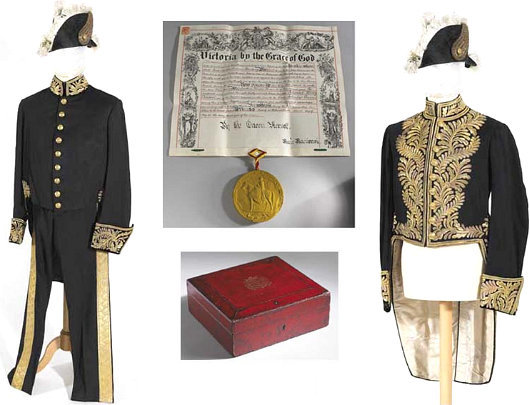
THOUGH THE BORING brains of tawdry metropolitan Londoners are all too quick at relegating Dublin to the provincial periphery of the mind, the Irish capital is a perpetual treasure trove for the old-fashioned and right-minded. A number of items of interests have recently been sold at the auction houses of the fair city, including two ceremonial uniforms (above) of that famous Dubliner, Sir Edward Carson QC. Carson was the lawyer and statesmen who passionately, but without bigotry, opposed the cause of Irish home rule. He was the defending barrister in the Archer-Shee case and led the Marquess of Queensberry’s team in Oscar Wilde’s doomed libel action. Carson and Wilde had been at Trinity together (where — little known fact! — Carson was a keen hurler), and the famous wit quipped of Carson “I trust he will conduct his cross-examination with all the added bitterness of an old friend.”
Having a fine mind for the law and being politically active meant that Carson moved through several layers of British government, holding numerous offices and positions. He was a Privy Counsellor twice over (of both Ireland and the United Kingdom), a Queen’s Counsel, served in the House of Commons as leader of the Irish Unionists, and held portfolios in the British Cabinet. The two ceremonial uniforms auctioned at Whyte’s of Molesworth Street are from his appointment as Solicitor General for England & Wales in 1900. (He had been Solicitor-General for Ireland in 1892, and was later Attorney General for England & Wales, in which position he was succeeded by the F.E. Smith of Chesterton’s famous poem).
The two black wool morning coats feature gold bullion trimming and buttons, and are sold with a pair of trousers with gold filigree stripe matching the lesser uniform, and knee breeches & silk stockings for the greater uniform. The vellum appointment as Solicitor General was also included, in a red leather box with a gilt impression of the royal arms. Whyte’s estimated a sale of €50,000-€70,000, but the lot’s realised price was €42,000.
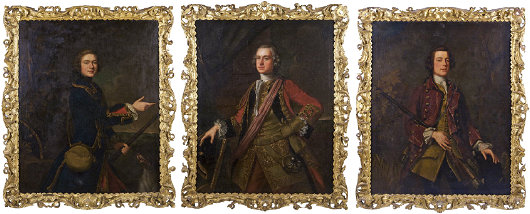
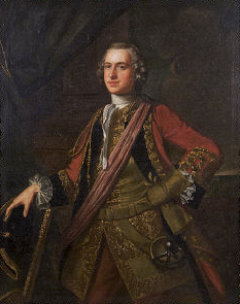 The Ulster-born painter Robert Hunter was one of the most prolific portraitist of late eighteenth-century Dublin, arguably the city’s (and country’s) golden age. Among his many works are these portraits of the three brothers King. Sir Robert King, 4th Baronet (left) was notorious as “a vile young rake” with vast estates in Roscommon, whose only interests were drinking, wenching, and spending. He once seduced the sixteen-year-old daughter of a tenant (who tried to force a marriage at pistol-point), fought in at least one duel, lived with his mistress in Dublin, was a Member of the Irish Parliament (before being made 1st Baron Kingsborough), and was Grand Master of the Irish Freemasons.
The Ulster-born painter Robert Hunter was one of the most prolific portraitist of late eighteenth-century Dublin, arguably the city’s (and country’s) golden age. Among his many works are these portraits of the three brothers King. Sir Robert King, 4th Baronet (left) was notorious as “a vile young rake” with vast estates in Roscommon, whose only interests were drinking, wenching, and spending. He once seduced the sixteen-year-old daughter of a tenant (who tried to force a marriage at pistol-point), fought in at least one duel, lived with his mistress in Dublin, was a Member of the Irish Parliament (before being made 1st Baron Kingsborough), and was Grand Master of the Irish Freemasons.
Hunter depicts the rake at three-quarter length, standing in a red coat with an embroidered waistcoat and sword, holding a tricorn hat. His brother Edward (5th Baronet after Robert’s death in 1755, made Baron 1764, Viscount 1766, and Earl 1768) is depicted with dog by his side and gun in hand. The third brother, Henry King (later the Rt. Hon. Colonel Henry King MP), Hunter shows in a red velvet coat and yellow waistcoat, again with a sporting dog by his side. All three portraits are 48 inches by 38½ inches in giltwood rococo frames from the period. Sir Robert King sold at James Adam & Co., St. Stephen’s Green, for €55,000, Sir Edward for €50,000, and Henry King for €38,000.
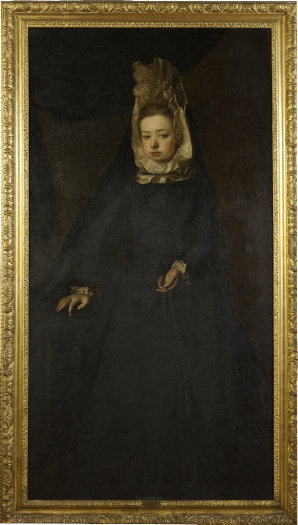 Garret Morphy (c. 1655-1715) is probably best known for his portrait of St. Oliver Plunkett, the most familiar image of that saint who is a Cusack kinsman and whose relics are enshrined at Downside Abbey in Somerset. Little is known about Morphy’s early training, but he moved back and forth between London and Dublin from the 1670s until settling permanently in the Irish capital in the mid-1690s. A Catholic himself, he painted portraits for many of the dwindling numbers of Catholic aristocracy and gentry whose final death knell was sounded by the Williamite victory at the Battle of the Boyne in 1690.
Garret Morphy (c. 1655-1715) is probably best known for his portrait of St. Oliver Plunkett, the most familiar image of that saint who is a Cusack kinsman and whose relics are enshrined at Downside Abbey in Somerset. Little is known about Morphy’s early training, but he moved back and forth between London and Dublin from the 1670s until settling permanently in the Irish capital in the mid-1690s. A Catholic himself, he painted portraits for many of the dwindling numbers of Catholic aristocracy and gentry whose final death knell was sounded by the Williamite victory at the Battle of the Boyne in 1690.
This portrait, depicting a black-clad woman holding a rosary, is attributed to Morphy and has traditionally been known to the King family as “Margaret O’Cahan” (oil on canvas, 69 in. x 35 in.). The fontage cap worn by the subject was widespread in 17th-century France, notably at the exiled court of James II, and survived in fashion no later than 1710. Prof. Anne Crookshank (of Trinity College Dublin) doubts it is actually a Morphy, citing its continental canvas, but Morphy probably did travel to France. As the catalogue entry notes, “Prof. Crookshank feels that this portrait is quite possibly of Florence O’Cahan, Margaret’s mother, and as such is a rare depiction of a member of the old Irish aristocracy in exile.”
Whether Florence or Margaret, the rather haunting and sad portrait was sold for €27,000 at Adam & Co’s October auction at Slane Castle.
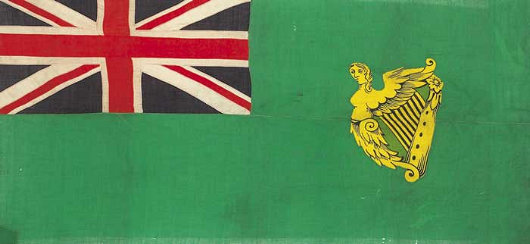
The “Green Ensign” never had any official sanction as the banner of Irish shipping, but evidence suggests it was used by some maritime merchants of the Emerald Isle from the seventeenth into the nineteenth centuries. In 1872, the Viceroy of Ireland, in reply to an Admiralty inquiry, clarified the use of the Green Ensign as incorrect, and attached a supportive essay by Sir J. Barnard-Burke, Ulster King of Arms (Ireland’s heraldic chief) expounding upon the tradition of blue as Ireland’s national colour. The gold-harp-on-blue remains in the Royal Standard of the United Kingdom of Great Britain & Northern Ireland and also forms the Presidential Standard of the Republic of Ireland.
This nineteenth-century Green Ensign (heavy cotton, 49 in. x 104 in.) is a rare surviving example of the flag, many of which were confiscated and destroyed by customs and Admiralty officials. Estimated to fetch no more than €500, competing vexillolophiles pushed the final sale price to €800 at Whyte’s in November.
Search
Instagram: @andcusack
Click here for my Instagram photos.Most Recent Posts
- Waarburg October 2, 2024
- A Prize for the General September 23, 2024
- Articles of Note: 17 September 2024 September 17, 2024
- Equality September 16, 2024
- Rough Notes of Kinderhook September 13, 2024
Most Recent Comments
Book Wishlist
Monthly Archives
Categories



It’s not quite correct to say that Carson played hurling. He was a member of the Dublin University Hurley Club, which played a type of hockey or hurling before either game had been codified. The current DU Hockey Club is the successor of the old Hurley Club, and plays in its colours: green and black. There was a short-lived gaelic hurling club in Trinity around 1882 and again around 1936. The current DU Hurling Club dates to 1960.
Aha! Many thanks for the clarification.
Interesting! I like the Morphy especially, or the alleged Morphy or whatever you want to call it.
Not sure about the “without bigotry” bit – he certainly knew how to mobilise the hardline Orange vote – in Britain as well as Ulster.
Shameless plug, but see my book on the subject: http://www.amazon.co.uk/Popular-Opposition-Irish-Edwardian-Britain/dp/1846311985
Great website!
I fail to see how an ability to mobilise a vote equates to bigotry. Carson supported the creation of a Catholic university for Ireland, and was intensely disappointed when Northern Ireland — despite his repeated warnings — became a Protestant-run state that oppressed its sizable Catholic minority.
“We used to say that we could not trust an Irish parliament in Dublin to do justice to the Protestant minority,” quoth Carson. “Let us take care that that reproach can no longer be made against your parliament, and from the outset let them see that the Catholic minority have nothing to fear from a Protestant majority.”
Unfortunately it was not the Edward Carson mentality which carried the day in Northern Ireland, but that of James Craig (Lord Craigavon) instead, who referred to a “Protestant Government for a Protestant People” and a “Protestant Parliament and a Protestant State” to the complete exclusion of Catholics from participation in civic life. The results speak for themselves.
It’s somewhat odd — in that way that things in history are often odd — that Carson is now so identified with Ulster; he was a Dubliner himself and turned down the premiership of Northern Ireland, a country that was not his own.
The whole premise of Carson’s opposition to Home Rule was that his Roman Catholic fellow-countrymen could not be trusted with power, even the limited power offered to them under the proposed Home Rule bills. Carson was also a member of the Orange Order, an organization steeped in Protestant triumphalism and anti-Catholicism. If that’s not bigotry, then what is?
Carson had no respect for the opinion of the majority of his countrymen, who supported Home Rule, or for the elected government in Westminster. He was ready to use German weaponry and rebellion to impose his will upon those who disagreed with him (the Larne Incident) and he forced the gerrymandered partition of his country to prop up a sectarian grab for power. The fact that he was willing to play nice with the disenfranchised nationalists that remained in the statelet has more to do with practicality than a lack of bigotry.
Also, Northern Ireland is either a province of the United Kingdom or part of a province of the nation of Ireland that is currently ruled from Westminster. Referring to it as a country smacks of last-ditch Loyalist paramilitarism.
Hogwash and hufflepuff!
Referring to Northern Ireland as a country is quite ordinary and perfectly acceptable. For example, it competes in international sporting competitions such as the Commonwealth Games and the Football World Cup as a country (though for the Rugby World Cup, the all-Ireland team has wisely been preserved).
Also, I think you’ll find that the United Kingdom does not have “provinces”, it has constituent “countries”, which in turn are traditionally divided into counties (which, for administrative purposes have been replaced with all manner of crazy units). England, Scotland, Wales, and Northern Ireland are countries.
Ulster, as opposed to Northern Ireland, is undoubtedly a province, and in the sense that, while inaccurate, it is sometimes acceptable to use “Ulster” as shorthand for “Northern Ireland” then so also I suppose it is sometimes acceptable to use “province” as a shorthand for “country”.
Returning to Carson, you cite no evidence that he had no respect for the opinion of the majority of his countrymen. I suspect he did have some respect for that opinion, but more importantly he disagreed with that opinion, and to disagree with an opinion is not the same as to disrespect it.
Carson was indeed, as you point out, involved in the Larne gun-running, but on multiple occasions he expressed his grave doubts over its wisdom and questioned whether it might have been folly.
Were I on the Ulster Protestant (and I am not) I might point out that the Nationalists were also guilty of precisely the same thing you accuse the Ulstermen of (being ready to use German weaponry and rebellion to impose their will upon those who disagreed with them). But this truth, while salient, in no way removes the guilt of the Ulster party.
Curiously, you claim that Carson “forced” the partition of Ireland, whereas I think you’ll find most historians and contemporary observers in agreement that partition was the next-to-last thing Carson wanted, and he only accepted it (just as Collins and co. only accepted it) as a last-ditch means of reducing bloodshed.
And there seems little practicality involved in what you call his “willingness to play nice” with the disenfranchised nationalists of N.I. Rather, if you actually investigate the career and life of Carson, it is perfectly fitting with his character. He had not one practical purpose in being nice to them, for he was not involved at all in the devolved Government of Northern Ireland. He represented an Ulster constituency at Westminster, but gave that up in 1921, and after partition he lived the rest of his life in England (he died in Kent).
The attempt to paint Edward Carson as Mr. Nasty Unionist is completely contradicted by historical fact. It seems odd that he is frequently the victim of these attempts, as he is one of the few Protestant figures popularly associated with Ulster who was not a nasty, virulent, Catholic-hating bigot. James Craig and his bigoted cohorts should provide enough fodder for those who want to feed their own feelings of victimisation and to vilify in its entirety Ulster Protestant culture (in a parallel fashion to the way post-Carson Unionists attempted to simply ignore and sideline Ulster Catholic culture). But we must give Sir Edward Carson his due.
Fair points. And I agree that Craig was more gung-ho than Carson who was quite a sensitive, complex figure – who talked often about how much he respected his RC fellow countrymen (although he is on record referring to the Pope as a “damned Italian priest” who had no right to meddle in Irish politics).
Nevertheless, Carson and Law were pretty adept at what we would now call “dog whistle” politics – and played the Orange card pretty ruthlessly. In fact, Carson’s private correspondence reveal that by 1914 he was pretty regretful about the sectarian strife that had been unleashed in Britain and Ireland through the campaign against Irish Home Rule (which, in hindsight, seems like one of the great missed opportunities given the growth of an insular, obscurantist theocracy in the South, and a repressive and violently sectarian cauldron in the North).
While I may not agree with everything you say (I dont think Dublin (ers) care what London thinks of us these days-we have produced great writers-Joyce, Beckett, rock bands U2,and even boy bands Westlife, Boyzone, who are globally aclaimed, etc and Im also not sure South Irelanders have the same view of Edward Carson as outsiders might)butI have to say your blog is really extraordinary and very interesting. I particularly am intrigued that Col Stauffenberg’s son is against the Lisbon Treaty (on another post) As you probably know, so were the people of Ireland until we were cajoled into accepting it. It makes you wonder?
Well I certainly never said that Dubliners care what London thinks. No one in their right mind should care what Londoners think (except for Londoners, of course).
Well said Mr. Cusack! It is always refreshing to read someone who attempts to move beyond nationalistic bigotry and rhetoric in regards to Ireland’s history.
Love the ‘bits’ on ZA too! Brings back good memories of a happy childhood spent in ‘die Moeder stad en die mooiste Kaap’.
Happy New Year.
Well, if you didnt mean to imply that to mention Dublin you first had to define it’s status in relation to “tawdry metropolitan Londoners ” in the first place, why not just leave London out of it? (Playing Devil’s Advocate, I guess?)
I just hate missing an opportunity to thumb my nose at London!
lol-yeah, I realise that. You probably know too that being proud of your country, or wanting to put your point across, does not mean you’re bigoted (re: Arnaud’s comment)